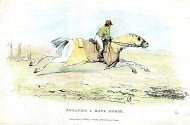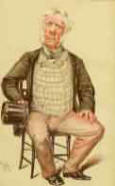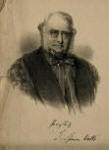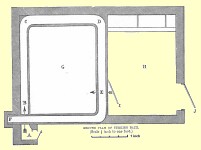3. Turkish baths for racehorses

Back on mainland Britain, it was the horseracing fraternity, rather than gentlemen farmers, who initially adopted the Turkish bath to protect their investment in stock, though again, not without controversy. Just as the bath was advocated as a panacea for all human ills, so it was with horse diseases.
In a seminal article, The Turkish bath as a means of training,17 published in The Field in April 1860 Admiral Henry John Rous argued that the traditional practice of sweating racehorses to remove unwanted fat by means of heavily clothed four or five mile gallops was unnecessary.

Traditional method of
sweating a racehorse
It left the horse exhausted, fit the following day only for a walk, and frequently resulted in accidents injuring the horse’s legs. But sweating in a Turkish bath was far more effective and left the horse lively and in peak condition. Furthermore there was a great improvement in the horse’s general health.
 Rous’s views were listened to with respect. As Frank Siltzer wrote38 in the 1920s,
Rous’s views were listened to with respect. As Frank Siltzer wrote38 in the 1920s,
[His] position as the sole arbiter of matters equine at Newmarket and elsewhere is without parallel in the history of the turf.
But, as so often with proselytisers, he overstated his case. It appeared to many that he was advocating the use of the Turkish bath instead of ordinary exercise, whereas it might have been more readily acceptable if recommended as a complement to exercise.
It was claimed that Thormanby, winner of the 1860 Oaks and Kettledrum, winner of the 1861 Derby, were both trained using the Turkish bath.
 However, two strong advocates of the Turkish bath brought some much needed reality to bear.
However, two strong advocates of the Turkish bath brought some much needed reality to bear.
Sir Thomas Spencer Wells, surgeon to Queen Victoria's household and specialist in ovarian diseases, had checked, and found that Thormanby had only taken the bath once when suffering from a cold.
A useful institution, he said, should not be brought into ridicule by over-praise.39
 Sir William James Erasmus Wilson, surgeon and specialist on diseases of the skin, had previously written a book on his journey round the spas of Europe, had a Turkish bath at home, was a director of the London & Provincial Turkish Bath Co Ltd, and wrote an excellent book on the Eastern, or Turkish bath.18
Sir William James Erasmus Wilson, surgeon and specialist on diseases of the skin, had previously written a book on his journey round the spas of Europe, had a Turkish bath at home, was a director of the London & Provincial Turkish Bath Co Ltd, and wrote an excellent book on the Eastern, or Turkish bath.18
He argued that like the prize-fighter, runner, or rower, ‘the racehorse must still have his muscles trained by exercise’ though the baths would ‘amply and sufficiently provide’ for the removal of fat.19
By 1861 several training stables had installed Turkish baths, while in Melton Mowbray, there was one for hunters.
A simple bath, such as the one at Brackley, Northamptonshire, used an enclosed and covered stall with a door (known as a loose box) in which the animal could be confined. A flue was fitted round the wall from an adjacent stove and insulation placed beneath the horse’s feet. The box was well ventilated, and a supply of drinking water provided. The temperature ranged from 120° to 140°F. Some horses went into the bath three or four times a week, others every day except Sunday.20
But there were also more elaborate facilities such as the two-room bath illustrated in Walsh’s 1862 manual, The Horse, in stable and field.21

‘The use of the Turkish bath for racers’, The Field had written a little earlier, ‘is spreading far and wide, the local prejudices of trainers succumbing to the manifest instances of its efficacy.'22
But not all trainers, and not for all purposes as Journeyman laconically notes in his appraisal of the racehorse Ben Jonson in George Moore's Esther Waters.23 Stack had asked whether a Derby winner with seven stone on his back might beat him.
Yes, but nothing short of that. Even then old Ben would make a race of it. A nailing good horse once. A little brown horse about fifteen two, as compact as a leg of Welsh mutton.... But there's no use in thinking of him. They've been trying for years to train him. Didn't they used to get the flesh off him in a Turkish bath? That was Fulton's notion. He used to say that it didn't matter 'ow you got the flesh off so long as you got it off. Every pound of flesh off the lungs is so much wind, he used to say. But the Turkish bath trained horses came to the post limp as old rags. If a 'orse 'asn't the legs you can't train him. Every pound of flesh yer take off must put a pound 'o 'ealth on. They'll do no good with old Ben, unless they've found out a way of growing on him a pair of new forelegs. The old ones won't do for my money.
The consensus seems to have followed W J Miles who, after quoting and critiquing Rous at length in Modern practical farriery,24 concluded that,
the hot-air bath will be found in practice rather a remedial application for abnormal states of the horse’s condition, or a direct agent for the removal of disease, than a systematic adjunct to ordinary training processes.
If Turkish baths appeared in mainland racing stables before farms, their later agricultural use was not without some success, as in Lord Kinnaird's farm, mentioned earlier.
Innovation is easily chronicled; it is more difficult to discover how long the Turkish bath survived in the countryside. But its use with working horses in the urban environment lasted well into the twentieth century.
